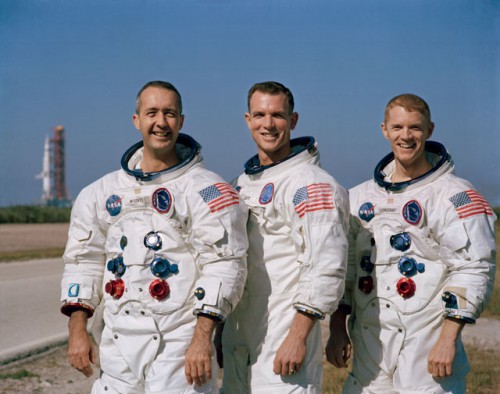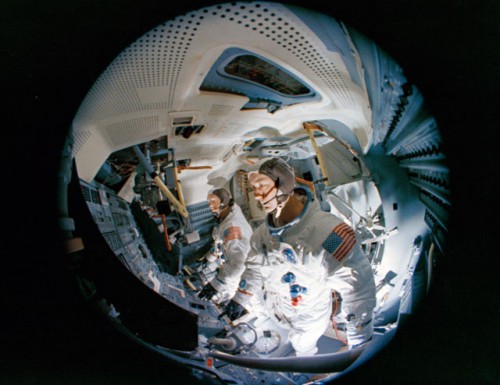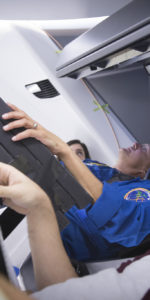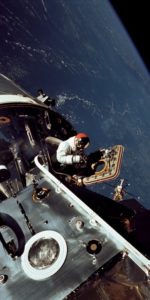
The year 1969 was pivotal in so many ways for humanity. At its dawn, American astronauts had newly returned from circling the Moon, and by July it had produced our first piloted landfall on another world. These astonishing achievements continue to resonate today—particularly following 2012’s untimely loss of Neil Armstrong—but there is one mission, flown in March 1969, which is a decidedly unsung hero of the effort to plant bootprints on the lunar surface. It rose only to low-Earth orbit, but without it those historic steps at the Sea of Tranquility could not have been taken. The mission was Apollo 9 and would be forever remembered as a mission of gumdrops and spiders, sickness and golden slippers…and the flight of “The Red Rover”.
By the beginning of 1969 the Apollo Command and Service Module (CSM) which would transport men to the Moon had been extensively tested, but an “all-up” demonstration of the entire ship, including the Lunar Module (LM), remained untried. Apollo 9 would be a tough mission, involving two separate manned spacecraft…and for Dave Scott, the Command Module Pilot (CMP), it encapsulated rendezvous, docking and an unspoken need to train for worst-case, what-if scenarios. If Commander Jim McDivitt and Lunar Module Pilot (LMP) Rusty Schweickart were unable to control the LM, Scott might be able to dock with them manually. But if not, the harrowing alternative was that he might have to abandon them and return home alone.
“Bringing Apollo home as a one-man show,” Scott wrote in his memoir, Two Sides of the Moon, “involved my mastering many aspects of all three jobs performed by the crew, Jim’s as commander, Rusty’s as systems engineer, my own as navigator. The sheer logistics of operating in all three positions, let alone learning the complex procedures this would require, was challenging, to say the least.”

During training, Scott had devised a routine in the simulator to handle this daunting role. First, he would check Apollo’s electrical, communications and environmental systems from Schweickart’s seat, then would move to the center couch to fulfil his own duties of setting up the relevant programs on the computer, before finally moving into McDivitt’s couch to perform the re-entry maneuver itself. “It was pretty exacting,” he wrote. Yet it was a dire eventuality for which all Apollo CMPs would have to be prepared.
Equally exacting was the possibility that Scott might have to rescue McDivitt and Schweickart if the LM developed problems. For example, if it was unable to initiate its correct rendezvous maneuver within a minute of when it was planned, he would need to rescue them. If the two craft successfully redocked, but the pressurized tunnel was inaccessible, or if the hatches failed to open, McDivitt and Schweickart would need to leave the LM in their suits and spacewalk back over to the command module’s side hatch. And this was hampered by the fact that McDivitt (who was not scheduled to make an EVA) would have been totally reliant upon Schweickart’s emergency oxygen supply. “If he didn’t make the EVA transfer within 45 minutes,” Scott wrote, darkly, “he would die.”
For months, the astronauts and their backups, Charles “Pete” Conrad, Dick Gordon and Al Bean, methodically rehearsed the complicated steps. “Our launch was almost postponed,” added Scott, “because we could not get enough training, especially for the rendezvous profile. After every sim was finished, we were debriefed and often had to explain why we had failed to deal with a particular situation. It was all pretty intense.”
Apollo 9 was indeed postponed, but not through lack of training. Originally set to fly on the last day of February 1969, the crew arrived at Cape Kennedy three weeks prior to launch to finish their training and quarantine. In the final days, McDivitt’s white blood-cell count was found to be low, hinting that he might be coming down with a cold.
By this time, the giant Saturn V booster had been sitting on swamp-fringed Pad 39A for almost two months and its 28-hour launch countdown had begun. Thirty minutes into a planned three-hour hold at T-16 hours, managers decided to recycle the clock to T-42 hours and give McDivitt time to recover his strength. Indeed, in his autobiography, Deke Slayton related that “all three of the crew came down with colds”, a suggestion which Scott and Schweickart attempted to dismiss by donning jogging clothes and running around the perimeter of the launch complex. Flight International quoted a medical report from the astronauts’ physician, Dr. Chuck Berry, which mentioned “sore throats and nose congestion.” Whatever the truth, it certainly illustrated, in Slayton’s mind, that the crews were being worked hard and were increasingly susceptible to “opportunistic infections”.
The brief postponement did not detract from what promised to be a spectacular, though challenging, year for NASA: the year in which the late President John F. Kennedy’s very public promise to land a man on the Moon would be realised. Up to five missions were planned, each one building on—and dependent on—the success of its predecessor. If the D mission was a success, the stage would be set for Tom Stafford, John Young and Gene Cernan on Apollo 10. Only if Stafford’s flight verified the performance of the LM’s engines and consolidated knowledge of the lunar gravitational field, could Apollo 11 stand any chance of touching down on the lunar soil.
Precisely on the stroke of 11:00 a.m. EST on 3 March 1969, the five mighty F-1 engines in the Saturn V’s first stage roared to life. McDivitt, Scott and Schweickart’s ride to orbit was virtually trouble-free, although the experience was truly unforgettable. For Scott, it was like being compressed and released atop a giant spring, as the forces and vibrations alternately threw them against their restraining straps, then smashed them back into their seats.

In space, Scott’s first task would make or break Apollo 9. Less than three hours after launch, he separated the CSM from the S-IVB final stage of the Saturn, whose adaptor panels were automatically jettisoned to expose LM-3. Using the thruster quads on the service module, Scott crisply turned his ship 180 degrees and prepared to dock with the spidery lander. At this point, the first problem arose when Scott found that his translational thrusters were not functioning properly. “If we couldn’t pull the lunar module out from its storage pod,” he wrote, “we didn’t have a mission. We had this short moment when it seemed it wasn’t going to work.” As he held the ship’s position steady, McDivitt and Schweickart scrambled to identify the cause of the problem. Eventually, it was traced to several of the attitude engine indicators, whose propellant valves were showing up as “closed”.
“After all the pre-flight testing of the valves,” Scott continued, “this was certainly not supposed to happen. At one point ground control thought one of us must have bumped several of the switches closed as we were jostled around during launch, but we were strapped into our seats so tightly this was impossible. Later analysis concluded that the valves had flicked shut as a result of the shock caused by staging.” The problem was fairly straightforward to rectify: McDivitt recycled the switches to “open” and Scott was able to execute a perfect nose-to-nose docking, a little over three hours into the mission.
In completing the first transposition and docking, the Apollo 9 crew had achieved the first American link-up between two pressurized, habitable spacecraft. The next order of business was to confirm that the docking probe and tunnel between the command and service modules and the lunar module was functional. Unlike the spacewalk by Soviet cosmonauts Yevgeni Khrunov and Alexei Yeliseyev in January 1969, McDivitt and Schweickart would transfer between ships internally, in shirtsleeves.
After pressurizing the tunnel between the two craft, verifying the integrity of the 12 latches on the docking ring, connecting umbilicals to provide the lunar module with electrical power, and disassembling the probe and drogue, it was time to separate from the S-IVB for good. Four hours into the mission, Scott threw a switch which fired pyrotechnics to release the lunar module from the S-IVB, and again pulsed the thruster quads to draw the complete Apollo craft free. Forty minutes after separation, the S-IVB’s restartable J-2 engine was lit again to enter an “intermediate coasting” orbit, preparatory for a third and final burn. The final firing, which began some six hours into the mission and burned until the propellant supply was all used up, allowed the S-IVB to escape Earth’s gravitational influence and established it in a solar orbit. Major objectives of the repeat firings were to demonstrate the J-2’s ability to restart and to test its performance under conditions beyond those for which it was designed.
In the meantime, McDivitt, Scott and Schweickart were preoccupied for the remainder of their first day in orbit with checks to ensure that the combined command, service, and lunar modules were spaceworthy. Among their initial tasks was a series of firings of the Service Propulsion System (SPS) engine, one of whose primary roles on missions to the Moon would be to perform the lunar-orbit-insertion and transearth injection burns. The first SPS burn, conducted late on 3 March and lasting five seconds, verified that the combined spacecraft could withstand the stress and gauge their “oscillatory response”.
With this work complete, the time finally came for the mission’s big deal—the checkout of LM-3 by McDivitt and Schweickart. After Schweickart made a dramatic spacewalk, the lunar module was to undock for a series of joint rendezvous exercises. During his planned two-hour excursion, Schweickart was to put the EVA suit with its bulky backpack, designed to enable astronauts to work on the lunar surface, through its paces. He was to exit through the small, square hatch and onto the lunar module’s front “porch”. Scott had spent more than two years perfecting his knowledge of the CSM, so McDivitt and Schweickart had devoted themselves to understanding every inch of “their” ship. Each man had prepared exhaustively for his respective tasks.
What they had not prepared for, or bargained on, was Schweickart’s adverse reaction to the space environment, which almost stalled the mission in its tracks.
The second part of this article will appear tomorrow.
Be sure to “LIKE” AmericaSpace on Facebook and follow us on Instagram & Twitter!
Missions » Apollo »




